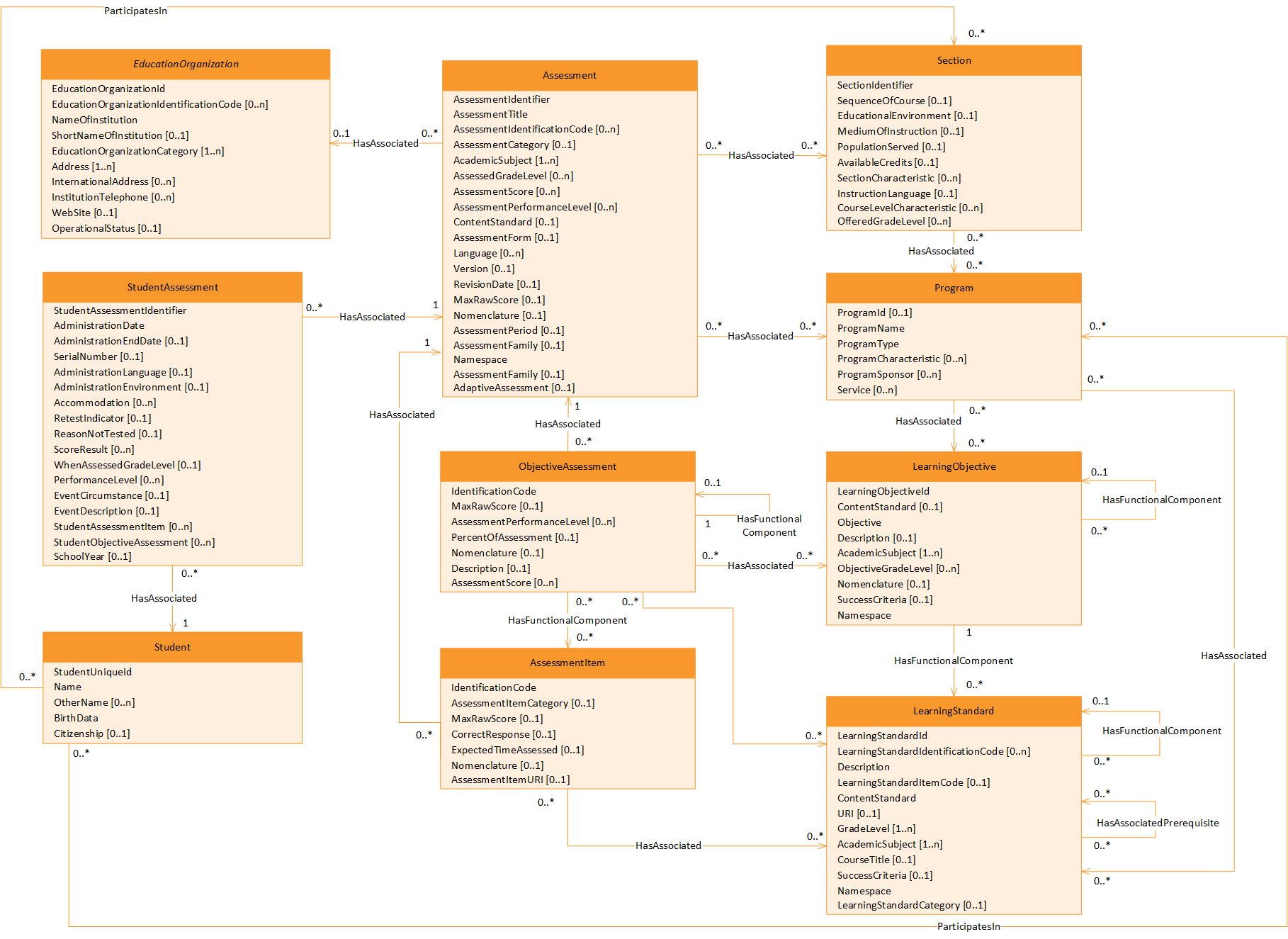The Ed-Fi “Classic Dashboards” are no longer supported through the Ed-Fi Alliance. You can still receive support and maintenance through the Ed-Fi vendor community. Please look at any of the vendors’ dashboard solutions on the Registry of Ed-Fi Badges or the Ed-Fi Starter Kits if you are looking for a visualization solution to use with the Ed-Fi ODS. This documentation will remain available to assist existing Classic Dashboard implementers.
Assessment Model Patterns in the Ed-Fi Data Standard v3.1
Itzel Torres
Ian Christopher (Deactivated)
The Ed-Fi Data Standard Assessment model contains a number of entities and reference patterns. This documentation provides an overview of the essentials useful to know when working with the Ed-Fi Dashboards. Additional detail is available in the Assessment Model v3.1 documentation.
The Assessment domain deals with the structure of assessments, the educational standards and objectives measured by assessments, and assessment results. The assessment model is suitable for a wide variety of assessments, including early childhood learning assessments, complex tests like state standardized assessments and college entrance exams, and simple tests like benchmark assessments and course assessments.
Key Entities
This domain contains:
- A LearningStandard entity that drives the curriculum and the assessments.
- An Assessment entity that describes assessments along with associated metadata.
- A StudentAssessmentResults entity that follows a parallel structure of StudentAssessment, StudentObjectiveAssessment, and StudentAssessmentItem.
Key Concepts
The key concepts include the following:
- Assessments are essentially tests, quizzes, or other instruments that evaluate student learning.
The overall domain is designed to capture student assessment results, not to recreate assessment instruments. The assessment instrument information is modeled to support recording and proper interpretation of a student’s results.
- The assessment model is flexible enough to convey results from complex tests such as the SAT and ACT exams, large tests such as state-level standardized tests, and simple tests such as classroom benchmark assessments or quizzes.
The LearningObjective entity usually models a general representation of an abstract learning concept or skill, whereas the LearningStandard entity models specific elements within the realm of an objective.
- The ObjectiveAssessment entity is essentially a grouping of items on an assessment that may have its own score and can be tied to learning objectives and learning standards.
The Ed-Fi data model for assessments contains a number of entities and reference patterns. While its scope may make it a bit imposing to newcomers, understanding a few design principles enable it to be easily understood and adopted.
Hierarchical Modeling
Many assessments are multi-tier in the sense that they provide multiple scores or result sets for each assessment. An example would be a single "reading" assessment that tested multiple skill areas, such as "Reading Comprehension," "Accuracy and Fluency," "Phonemic Awareness," and so forth.
In the Assessment domain, the top-level assessment is an Assessment entity and the skill areas are ObjectiveAssessment entities. This structure is recursive, so that there can be any number of levels of ObjectiveAssessments.
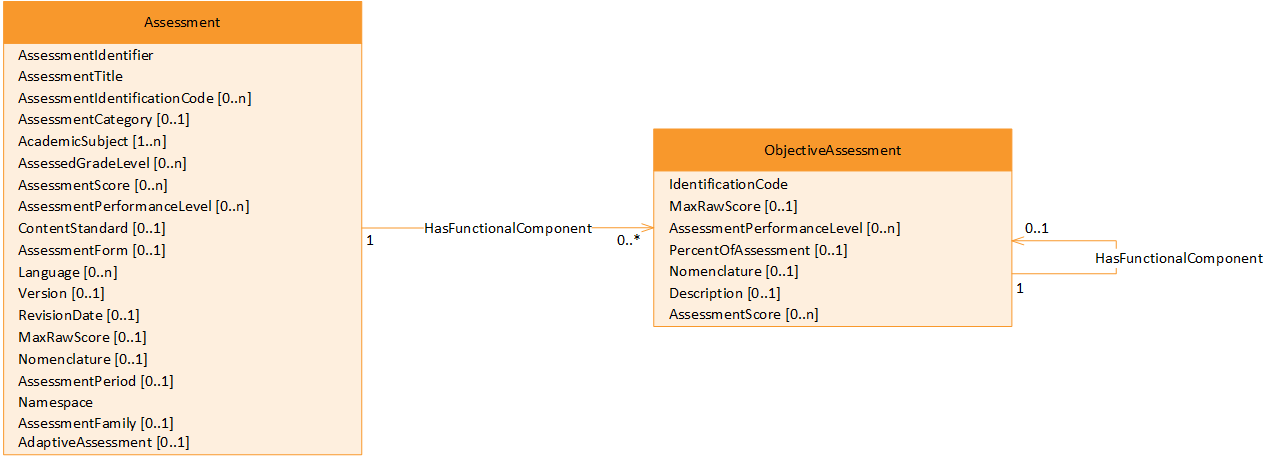
Once a student takes an assessment, the results can be modeled in the StudentAssessment entity and StudentObjectiveAssessment common type, each of which has references back to its parent or peer entities.
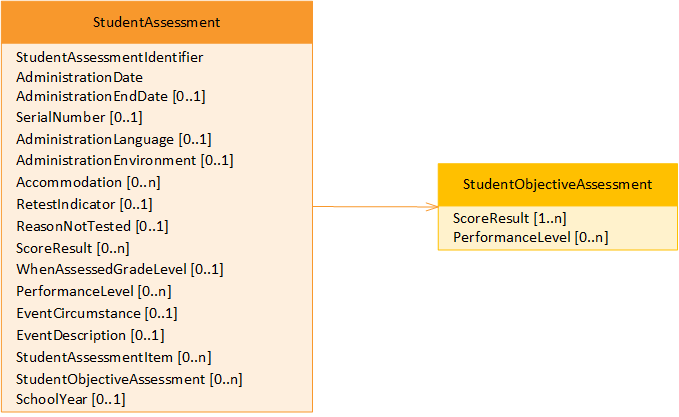
Support for Mapping to Local Learning Objectives and Learning Standards
Field implementation has shown that, while school systems will intake into their systems the results of student assessments in areas like "Reading Comprehension" (in other words, the ObjectiveAssessment entity with student results held in the StudentObjectiveAssessment entity), they also commonly need to map those "Reading Comprehension" results to local learning benchmarks. The LearningObjective entity enables the ObjectiveAssessment to be mapped to a local benchmark. Further, the LearningObjective entity may be mapped to a formal, external learning standard, such as one provided by the state or Common Core State Standards.
The structure looks like this:
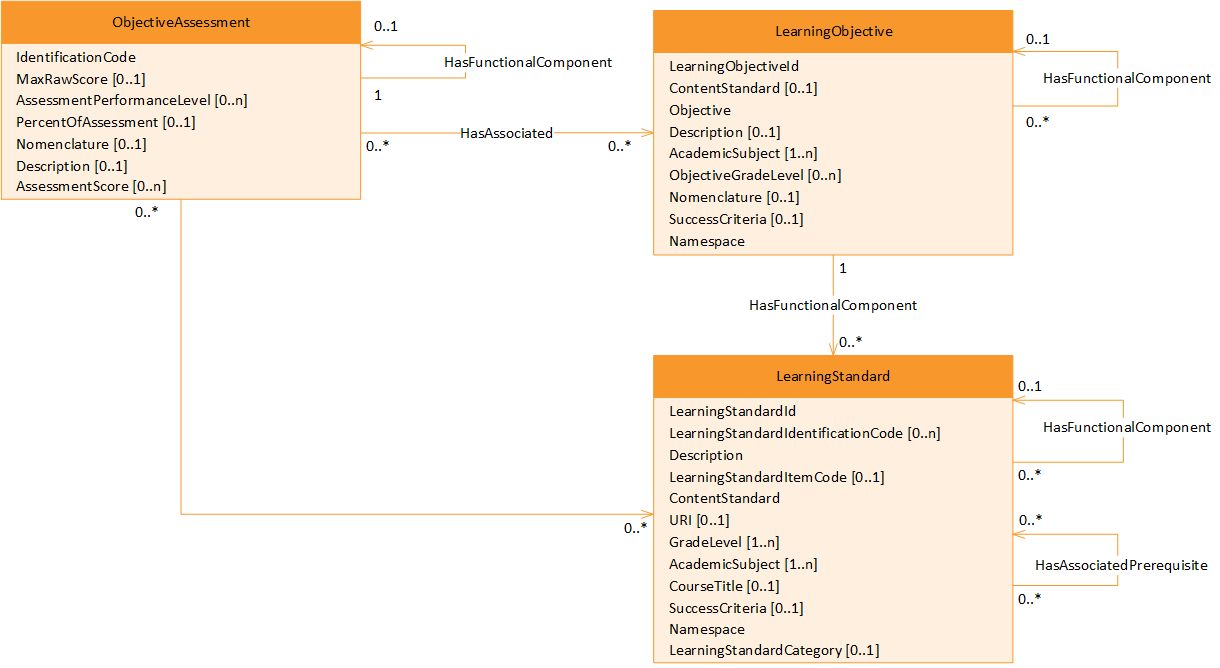
The source of the data is typically as follows:
| Ed-Fi Entity | |||
| ObjectiveAssessment | LearningObjective | LearningStandard | |
| Who provides ("owns") the entity data? | The assessment provider | The local school agency | A third party |
| Example of a provider | "DIBELS" | "Grand Bend School District" | "Common Core State Standards" |
The practice of mapping to a local benchmark is not universal, and so it is also possible to associate a LearningStandard from an ObjectiveAssessment, as shown in the diagram below:

Who "Owns" What (or, Where Does the Data Come From)?
The assessment model combines data that originate with many entities, for example:
- An assessment provider (College Board, DIBELS, NWEA, or any number of useful new web tools) is generally the provider of the core metadata for what the assessment looks like and what it is assessing. This information maps to the Assessment, ObjectiveAssessment, and AssessmentItems entities.
- A student generates data when interacting with an assessment. This information generally maps to the StudentAssessment and StudentObjectiveAssesment entities.
- The enterprise hosting or managing the data often provides contextual metadata, mapping the provider elements to local standards via the LearningObjectives entity. The LearningStandard entity is often managed by the enterprise as well.
The following diagram captures this:
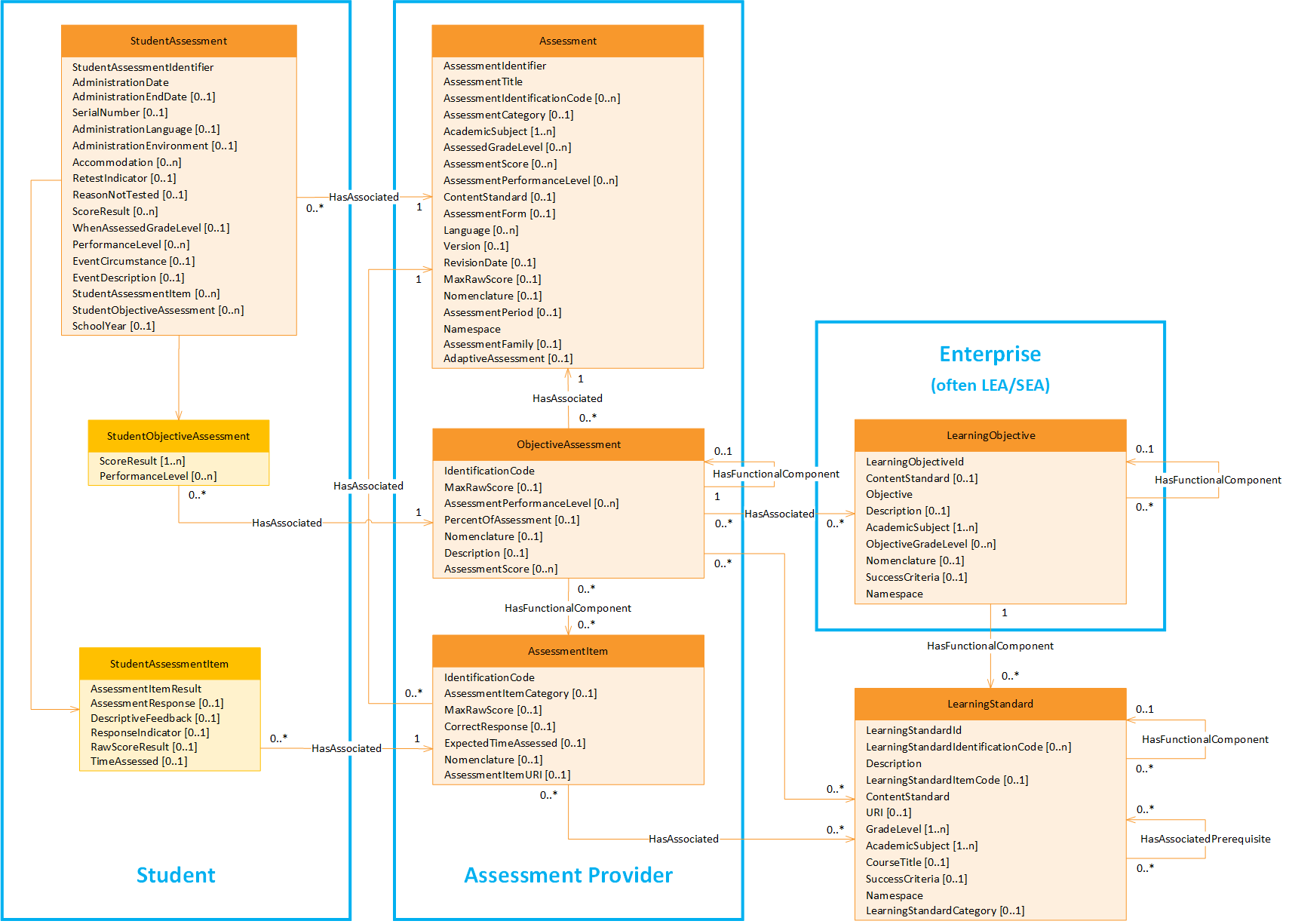
CompetencyObjective vs. LearningObjectives
Students, and particularly students in lower grades, are often assessed on skills that are more developmental than academic. "Plays well with others" or "Pays attention in class" are typical examples. In the Ed-Fi Assessment domain, these are typically modeled as CompetencyObjectives to distinguish them from the more formal LearningObjectives.
Model Reference
This section contains reference information for the Assessment domain model.
Learning Standard Subdomain
Many states have learning standards that drive the curriculum and the assessments. The Common Core State Standards Initiative (www.corestandards.org) is a national initiative for standards in this area. For states that use the Common Core, or have their own standards, the assessment model has entities for LearningStandard, which represents the lowest level of skills, and LearningObjective, which represents higher level aggregation of skills, as shown below. The model supports a hierarchical taxonomy of learning skills using multiple levels of LearningObjective, which may correspond to levels of subjects, domains, or strands; the Nomenclature element captures the appropriate naming of these levels whereas the SuccessCriteria element captures the criterion that teacher and students use to check for attainment of the objective.
The LearningStandard entity may also be hierarchically organized to support the use case that adopters of the Common Core often decompose a standard into lower level standards in their curriculum. The HasAssociatedPrerequisite association captures prerequisites for a learning standard as would be specified in a learning map.
Assessment, Learning Standards Model
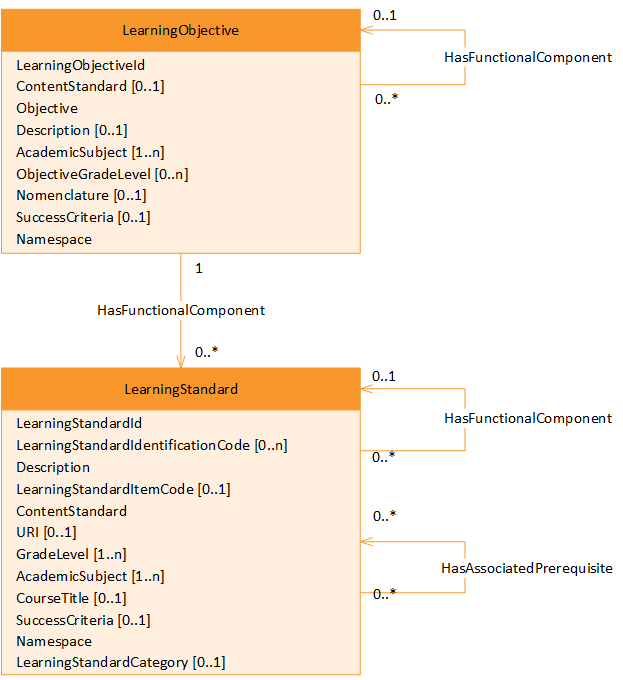
Assessment Metadata Subdomain
Assessment metadata is information describing the assessment instrument itself.
There are two options to associate an Assessment that are mutually exclusive: by Section and by Program. For example, if an Assessment is defined to assess Common Core Standards, then the association shall be with Section. On the other hand, if the Assessment is defined to assess the Developmental Domains by an Early Learning program, then the association shall be with Program.
Assessment, Assessment Metadata Model
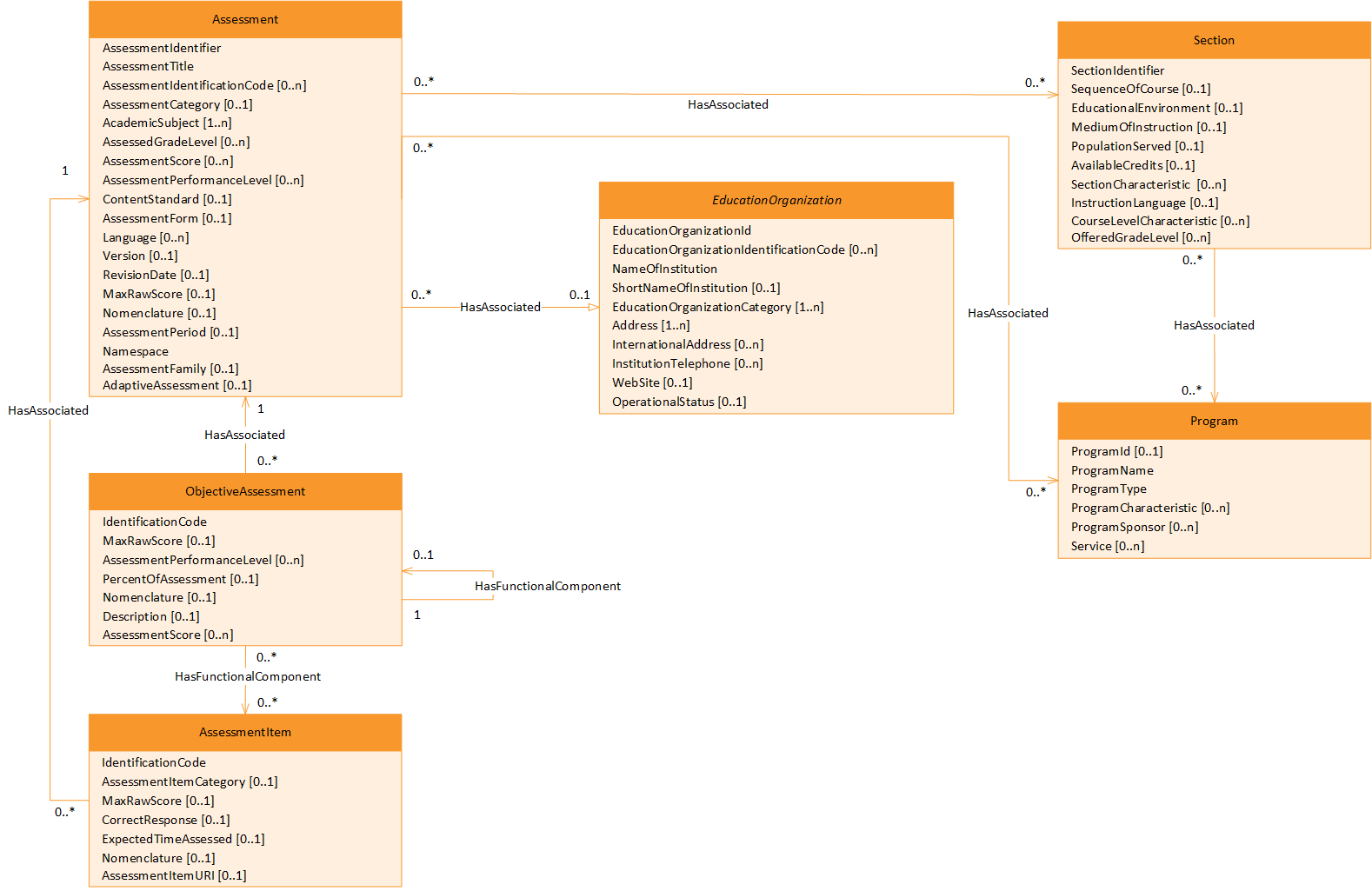
Student Assessment Subdomain
The Assessment entity represents a specific administration of an assessment. The Assessment entity contains the minimum amount of metadata required for an assessment.
- If the Assessment entity is associated with one or more sections, an association is made to the section(s).
- The ObjectiveAssessment entity is the optional identification of portions of the assessment that test specific learning objectives. If required, there can be multiple levels of hierarchical ObjectiveAssessments entities.
- The AssessmentItem entity supports the optional identification of the individual questions or items on a test to be scored. Typically, the identification of AssessmentItems entities is done in conjunction with their mapping to LearningStandards entities.
- If the assessment references the Common Core or other state standards for LearningStandards and LearningObjectives entities, then the assessment metadata would reference the preloaded standards. If the assessment references its own set of LearningObjectives and/or LearningStandards entities, then that data would be loaded as assessment metadata. An ObjectiveAssessment entity may test one or more LearningObjectives entities, and/or may test one or more LearningStandards entities.
The student's assessment results follow a similar structure to the assessment metadata.
- The StudentAssessment entity holds the overall assessment score and other information about a specific student's results for a specific assessment. This entity is associated with a specific student.
- The StudentObjectiveAssessment common type included in the StudentAssessment entity optionally holds the student's score for individually scored results for a specific learning objective. If the assessment metadata includes objective assessments, then there would be corresponding StudentObjectiveAssessments entities for each student.
- The StudentAssessmentItem common type included in the StudentAssessment entity optionally holds the student's score for individual AssessmentItems entities. If the assessment metadata includes AssessmentItems, then there would be corresponding StudentAssessmentItems entities for each student.
Assessment, Student Assessment Model
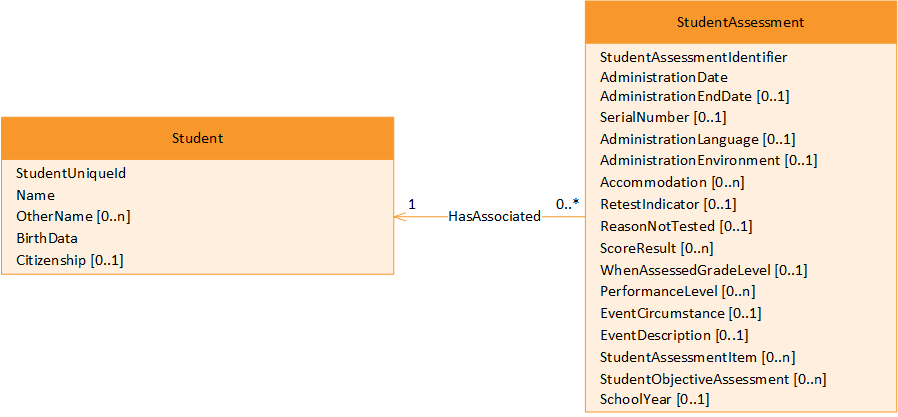
Assessment Model Entities
Name | Description |
|---|---|
| Assessment | This entity represents a tool, instrument, process, or exhibition composed of a systematic sampling of behavior for measuring a student's competence, knowledge,skills, or behavior. An assessment can be used to measure differences inindividuals or groups and changes in performance from one occasion to the next. |
| AssessmentItem | This entity represents one of many single measures that make up an assessment. |
| LearningObjective | This entity represents identified learning objectives for courses in specific grades. |
| LearningStandard | This entity is a sub-element of a learning objective consisting of a precise statement of the expectation of a student's proficiency. |
| ObjectiveAssessment | This entity represents subtests that assess specific learning objectives. |
| Program | This entity represents any program designed to work in conjunction with, or as a supplement to, the main academic program. Programs may provide instruction, training, services, or benefits through federal, state, or local agencies. Programs may also include organized extracurricular activities for students. |
| Section | This entity represents a setting in which organized instruction of course content is provided, in-person or otherwise, to one or more students for a given period of time. A course offering may be offered to more than one section. |
| Student | This entity represents an individual for whom instruction, services, and/or care are provided in an early childhood, elementary, or secondary educational program under the jurisdiction of a school, education agency or other institution or program. A student is a person who has been enrolled in a school or other educational institution. |
| StudentAssessment | This entity represents the analysis or scoring of a student's response on an assessment. The analysis results in a value that represents a student's performance on a set of items on a test. |
Assessment Model
